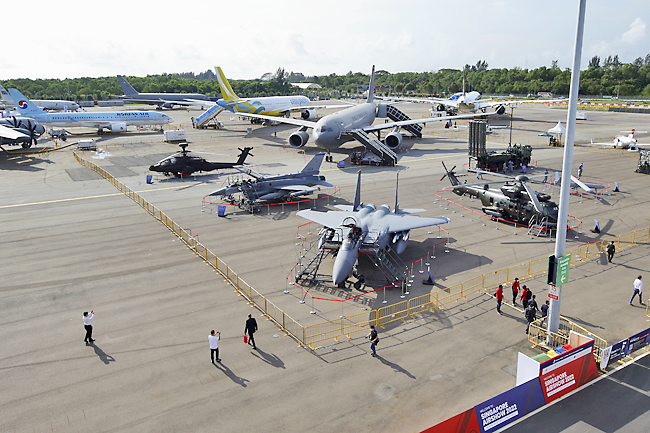SINGAPORE (AP) – Singapore’s biennial air show opened yesterday on a smaller scale than before the pandemic, even as the aviation sector gears up for a recovery two years after coronavirus outbreaks nearly paralysed air travel.
The three-day air show began yesterday. Members of the general public are not allowed, but about 600 exhibitors are showing their products and services.
That’s down from 930 during the last show in February 2020, when coronavirus cases were just beginning to rise.
Experts said the aviation market is poised for recovery, with defence spending on the rise and commercial aviation picking up despite the latest wave of Omicron-driven infections.
Those attending the show must observe stringent coronavirus rules including regular COVID-19 testing and potential isolation for those found infected with the coronavirus.
The air show began in 2008. It typically attracts senior corporate executives of aviation companies and delegations from countries around the world. About 13,000 people are expected to attend this year’s show, less than half the 30,000 who visited in 2020.
Many Southeast Asian countries have kept their borders closed or imposed strict limits and quarantine and testing requirements to try to curb outbreaks that have ravaged most countries. Some are now slowly relaxing those precautions.

“The air show comes at an interesting time, because the market in Southeast Asia is finally starting to recover after almost two years of decimated impact on air travel, particularly in the international market,” said Brendan Sobie, an independent aviation and aerospace analyst based in Singapore.
Many Chinese companies are staying away from this year’s show, likely because of Beijing’s “zero-COVID” policies that involve lengthy quarantines.
Major exhibitors at this year’s show include Boeing, Airbus and Lockheed Martin. Boeing’s newest widebody jet, the 777X, made its Asian debut at this year’s show, demonstrating aerial manoeuvers during a daily flight display.
The 777X is about 20 per cent more fuel efficient than the aircraft it replaces, according to vice president of marketing for Boeing’s commercial airplanes Darren Hulst. Singapore Airlines is among Boeing customers planning to include the new jet in their fleets.
“The number one trend we’re seeing is how resilient the demand for aviation is and how important it is for people to connect,” Hulst said in an interview yesterday. He noted that short-haul flights have recovered quickly in regions like the United States (US), where high gas prices are discouraging people from traveling by car.
“As we see the industry recover more, as more and more restrictions are lifted on long haul travel, we’ll see the market continue to recover and we think the industry will be back to where it was in 2019 somewhere by the end of 2023 or early 2024,” Hulst said.
Boeing rival Airbus said on Monday that it had confirmed 48 orders for new aircraft – 28 A320neos for Kuwait’s Jazeera Airways, and 20 Airbus A220s for United States (US)-based aircraft leasing firm Aviation Capital Group.
China’s absence at the show leaves a big gap, said Sobie. Chinese tourists usually are the world’s biggest spenders, having splashed out USD254.6 billion on overseas travel in 2019, according to the UN’s World Tourism Organization.
“It’s not about them not participating in the show necessarily. It’s about them not participating in the recovery of the international aviation industry,” he said.
“China is a very important market for Asia and in particular, Southeast Asia relies very heavily on China,” he said. “So it’s an extremely important market that has to recover in order for the market overall to fully recover.”




